ESS (Term 1 Semester 1.0)
Objective:
Understand and Recognize your EVS.
Ecocentric, Technocentric, & Anthropocentric (1.1)
Water cycle: Evaporation → Condensation → Precipitation → Transpiration (Trees/ Plants) → Surface run off → Grounf water.
What’s ‘EVS’?
Worldview that shapes how society views and evaluates environmental issues influenced by: Cultural, Religious, Economic, and Socio-political context.
→ What are the things that influence the way people view environmental issues? (Input)
Education, experience, culture, and media.
→ What are the things that EVS contains? (Output)
Set of interconnected premises, values, and arguments that generate consistent decisions and evaluations.
What are the 3 EVS?
Ecocentric, Anthropocentric, and Technocentric.
→ What’s an ecocentric viewpoint? (Nature centered)
It puts ecology and nature as central to humanity and emphasizes a less materialistic approach to life with greater self-sufficiency of societies.
What do they prioritize?
They prioritize nature rights
What do they emphasize on?
Importance of education and encourages self-restraint in human behavior.
What are ‘extreme ecocentrics’ also known as? Deep Ecologists (They believe humans are not any more important than any other living thing and that we should consume less as well).
What do ‘Deep Ecologists’ believe in? They believe that everyone should be involved in making decisions regarding the environment.
What do ‘Soft Ecologist’ believe in? They prefer small scale actions. They believe that individuals make a difference, and against large scale profits.
What do ‘Environmental managers’ believe in? They believe that the environment can be used and preserved if managed properly.
→ What’s anthropocentric? (People centered)
They argue that humans must sustainably manage the global system.
What would anthropocentrics suggest to resolve an environmental problem?
Through a debate to reach a consensual, pragmatic approach to solving environmental problems.
→ What’s technocentric? (Technology centered)
They argue that technological developments can provide solutions to environmental problems.
What method would technocentrics suggest to solve environmental problems?
Scientific research, to understand how systems can be controlled manipulated/ changed to solve resource depletion.
What do technocentric deemed necessary for society’s improvement?
Pro-growth agenda. → Publicyly support the exploitation of land/ natural resources
What are ‘Extreme Technocentrics’ also known as? Cornucopians
What do ‘Cornucopians’ believe in? That economic growth and capitalism is the best way to manage free market economy
Capitalism and the Environment
What do capitalists believe? They believe that economic growth is put above all other factors, and this growth is above environmental values.
Who are to blame for environmental degradation in capitalist areas? Private businesses. → Why?
Communism and the Environment
Who are victims of “tragedy of the commons”? Communist societies.
What happens when no one owns the resource? No one cares for it.
more economically developed countries (MEDCs) → Ex. United States, Canada, Japan, Australia, New Zealand. Countries with less developed economies are called less economically developed countries (LEDCs) → Ex. Cambodia, Indonesia, and Afghanistan.
Greenhouse gases is causing global warming.
Whats environmental value system?
Its a “World view” or set of paradigms that shape the ways that individuals and groups approach environmental issues.
Ecocentrism (Nature and ecology Centered) → Bio-rights
Nature: Environmental conservation is central to decision-making.
Society: Humans are part of nature.
Individual responsibility and accountability.
All life has inherent value.
We should not cause the extinction of other species.
We should protect habitats and ecosystems.
Humans are not more important than other species.
Resources are limited so we have to be careful.
We need the earth more than it needs us.
Chief Seattle, Aldo Leopold (1949)→ A Sand County Almanac, Mahatma Gandhi is ecocentric.
Self restraints in human behavior, and less materialism.
What should we do about climate change? (Their suggestions)
Travel by bike
Dont travel by plane
Turn light off
Close down factories → economic development isnt as important as protecting organisms.
Anthropocentrism (people (humanity) centered)
Nature: The environment is a resource for humans to use as needed.
Society: Human health and well-being are central in decision-making.
People as environmental managers of the environment.
Governmental regulation, taxes, legislation, and regulation.
Population control given equal weight to resource use.
Humans are the most important species.
People living in MEDC’s (more economically developed countries)
are more likely to hold this view. WHY?
Rchel Carson, is Anthropocentrism and Ecocentrism. George W Bush, Barrack Obama is Anthro.
Humans can “manage” the issues.
Protect “useful” species.
What should we do about climate change? (their suggestions for solving environmental problems)
Raise taxes/petrol/fuels.
Create laws on “clean” fuel and energy.
Carbon Taxes
Take action so that it doesnt harm us in the future
Technocentrism
Nature: Nature is a model, but can be replaced by technology when needed.
Society: Human health and well-being are central to decision-making.
Technology can keep pace with and provide solutions to environmental problems.
We must understand natural processes in order to manage and control these resources.
We can solve any problem we cause. (That means I can employ technology to resolve it)
Economic growth is a good thing.
Solve problems while increasing living standards.
Economic growth improves technology = care for the earth as we need to.
What should we do about global climate change? (their suggestions for solving environmental problems)
Solar/ wind power
Improve the efficiency of cards
Adjust to new global climate
Use technology
EVS Spectrum
Deep Ecologists (Extreme Ecocentric)
Nature > humanity
Humans are not any more important than any other living thing.
All natural resources are for human use. Humans should consume less.
Seek a more holistic view of the world we live in.
We MUST completyely change our behavior, by prioritizing living things and the planet.
Self reliance (Soft ecologist) → prefer small scale (start small, start from your own environment)
Small-scale, local community action.
Individuals make a difference. each individuals should start making small actions, the world would change.
Self-sufficiency in resource management.
Ecological understand a principle for all aspect of living.
Environmental Managers (More anthropocentric) →environment can be used if managed properly.
Earth needs tending
Governments legislate and protect the environment
No radical political agenda but promote working to create change within the existing social and political structures.
Current economic growth can be sustained if environmental issues are managed by legal means or political agreement.
Conucopians (Extreme Ecocentric)
Earth is unlimited. We can do anything, and there might be consequences but we are able to deal with it.
There is no correct environmental value systems.
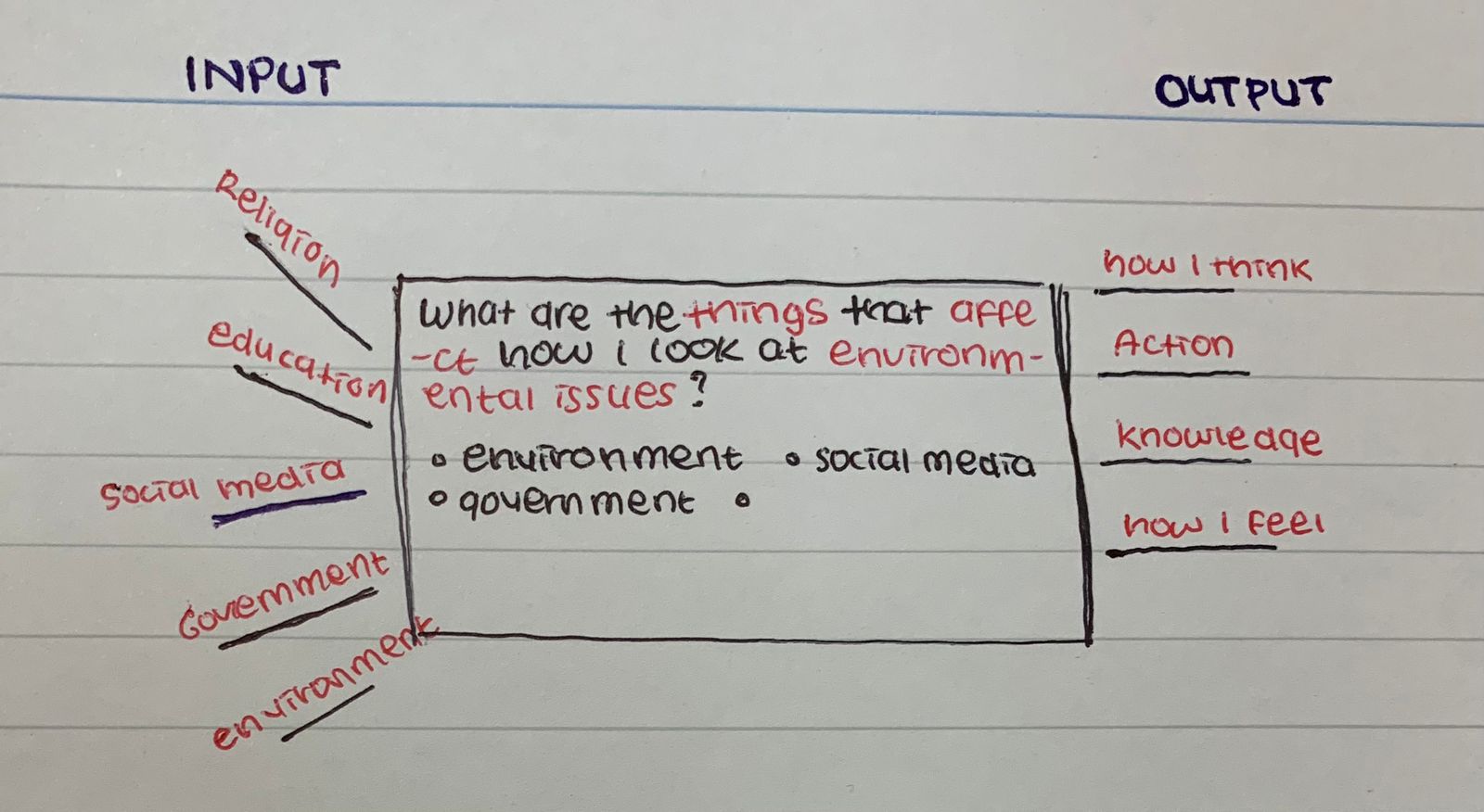
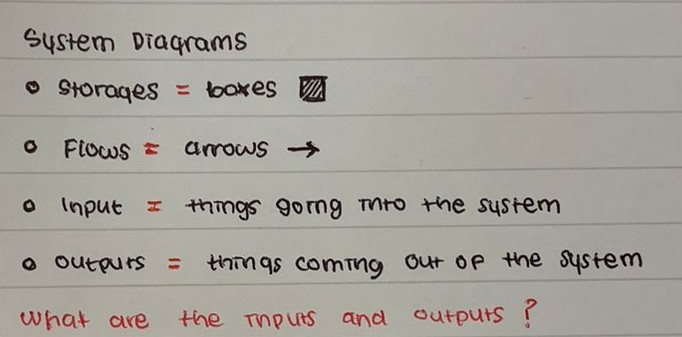
Open, Isolated, & Close system (1.2)
What’s a system? Its an organized collection of interdependent components that perform a function and which are connected through the transfer of energy and or matter.
All are linked together and affect each other.
Reductionist vs Holistic approach
Whats the reductionist approach? Its looking at individual parts.
What’s a Holistic approach: Looking at how everything works together.
Gaia Hypothesis - James Lovelock
The key aspect of the Gaia hypothesis is the concept of feedback mechanisms. Lovelock suggested that organisms and their environment are linked through feedback loops that help regulate various factors.
3 Types of Systems
Open → Matter/ energy is able to go in and out.
Examples: (1) Tree - They take in solar energy and carbon dioxide, (2) Turbine - where the system boundary is the turbine housing. The turbine sucks in air through the boundary, which results in a mass flow. The air is then compressed and mixed with fuel and heated (combustion of fuel), which then lead s to a strong expansion of the gas.
Close → Matter cannot go in or out. Energy can.
Examples: (1) Air conditioner, (2) Electric hair straightner.
“Biospeher II” Experiment as an attempt to model close system.
It doesnt occur on earth, but all global cycles (e.g. water nitrogen cycles), approximate to closed systems.
Isolated → does not have a net external force and does not exchange matter or energy with its surroundings.
No totally isolated examples. Most examples have minimum absorption of energy.
Flows/ Processes can be either transfer or transformations
What’s transformations? When matter or energy change form or state moving through a system.
What interaction does it lead to? It leads to an interaction within a system in the formation of a new end product or involves a change of state.
Examples of these are:
Solar energy → glucose (through photosynthesis)
Burning fossil fuels (matter to energy)
Water evaporating off the earth’s surface (matter to matter)
Light energy to electrical energy in a solar panel (energy to energy)
What’s transfers? matter and energy moving through a system without changing form or state.
What does it usually involve? A change of location.
Examples: Movement of materials through a food chain (one animal eats another).
Movement of materials in a non-living process (water carried to the ocean).
Movement of energy (ocean current or wind transfer heat).
MODELS: Benefits
An example of system diagrams is a model.
What does models show?
To show concepts on a scale that is manageable.
What are its benefits?
Simplifies complex systems Why? in order to study them more closely.
Allow us to make predictions about future events.
Allows us to look at different scenarios, Why? so we can look at the impact that was caused by changes that occurred in the system.
Allow us to discuss and consult with other experts.
Useful for understanding and explaining phenomena.
What are the possible problems with models?
Models could lose its meaning when its oversimplified.
Models and predictions depend on the skills and experience of the people making them.
Models could be interpreted differently.
Different models of same system may predict different outcomes.
Data may not be accurate so models could be used to manipulate for financial or political gain.
Green Politics Decision Making (1.3)
Intrinsic Value → A characteristic of a natural system that has an inherent worth,regardless of economic considerations.
Include values based on - culture, aesthetics, and bequest significance (value to children and grandchildren).
It does not have an economic worth, but intrinsic worth → Valuable bc of its cultural value. It has worth because it has something unique or interesting.
Different EVS ascribe different intrinsic values to components of the biosphere:
Ecological values = no market price.
Ecosystems valued on intrinsic grounds may not provide identifiable goods or services and thus may remain underpriced or undervalued from an economic view.
Green politic → group of people that aims to solve issues and press through politics and discussion (theyre always ecocentric→ theyre looking for sustainable and ecologically society)
Ex. Green party in New Zealend, Green campaigners in UK, and in Indonesia Indonesian Justice and Unity Party (Partai Keadilan dan Persatuan Indonesia)
Ideology →
How important is it in rainforest conservation?
Examples of issues where green politics influenced the EVS of people in Indonesia
Does energy change? Yes,but it cant ever be destroyed or created.
Example of energy flow is food chain.
What’s the 1st law of thermo dynamics? is the principle of conservative energy, which states that energy in an isolated system can be transformed but cannot be created or destroyed.
1st and 2nd Law of Thermodynamics
1st Law of Thermo dynamics
Amount of energy within a system is constant. The form of energy changes.
Implications of 1st law of Thermodynamics → Energy cannot be created or destroyed.
If its an open system (ecosystem), once energy entered it cannot increase.
Why is it important for energy to keep entering? To keep the flow.
Food chain, energy transforms from light → chemical → heat energy.
This Increases entropy (measure of disorderlyness), so theres less available energy to do work, therefore at higher trophic levels there are fewer animals.
Animals at higher trophic levels must eat a large number of smaller animals, so if there are non-biodegradable in the chain they will become more progressively concentrated. → Basically they will be affected more. (Bioaccumulations).
Energy cannot be created, so we have to use what is available and transform it to a form thats most useful to us.
No new energy is created in the universe
Food Chains
Chemical energy passes along the food chain (in the direction of the arrow).
As consumers eat producers/ other consumers, some chemical energy is converted into mechanical energy during respiration so that it can be used to fuel life processes.
Energy Production
Coal is burnt to alter the chemical bonds and release heat.
The heat then turns water to gas (steam).
The steam spins a turbine (kinetic energy).
Drives an electrical generator to produce electricity (electrical energy)
2nd Law of Thermodynamics
Notes taken in class:
Energy can only be converted from one form to another.
Potential energy → what you store in your body. Energy stored → fat.
What is Fat considered as? Since fat will convert to energy, its instant energy.
90%/1800 kj of energy will be used by living species in daily actions. 10%/200kj energy is stored.
2000kj is something that is consumed by that living species, in this context is a cow.
Universe loves disorderlyness → the more disorderlyness, the better it is.
We have small food chain because → energy loss (as heat/ feces).
Vegans → GET MORE ENERGY BC THEY ONLY EAT PLANTS MOO.
2nd law → Energy is always lost in a system to a less useful form.
What’s Entropy? Its the amount of disorder in a system.
Entropy increases = energy is used (LESS energy for work)
Less energy at each level - ecological pyramids.
Transformations are not efficient.
Living systems require constant input of new energy from the Sun.
Available energy decreases with time as order takes energy.
Energy transfer is not 100% effective.
There is less and less available energy in each successive level.
10% available
What does Entropy favor? Entropy→ favors chaos. The more the chaos is, the more it is favored
Entropy increases when we move.
The major difference of animal cells, and plant cells.
Plant cells → It has an additional wall around it (its made of - cellulose → Long chain of carbon).
Forest fire: Cellulose + Oxygen (High potential energy) → Carbon monoxide (H2o), Carbon dioxide (CO2), heat, light, sound, & carbon. (Low potential energy)→ It becomes unorganized.
That was an example of increase entropy → meaning that there is more chaos.
What happens to potential energy when entrophy increases? Potential energy decrease < while entropy increases.
Animal cells →
Entropy always increases (less energy for work)
Less energy at each level ecological pyramids
Transformations are not efficient
Living systems require constant input of new energy from the sun
Wolf 4200 kg/km2
Red Fox 2100 kg/km2
Snowshoe hare 20,925 kg/km2
Grass 2.0925 x 10’7 kg/km2

Available energy decrease with time as order takes energy.
Energy transfer is not 100% effective.
There is less and less available energy in each successive level.
10% available.
The second law explains the inefficiency and decrease in available energy along a food chain and energy generation.
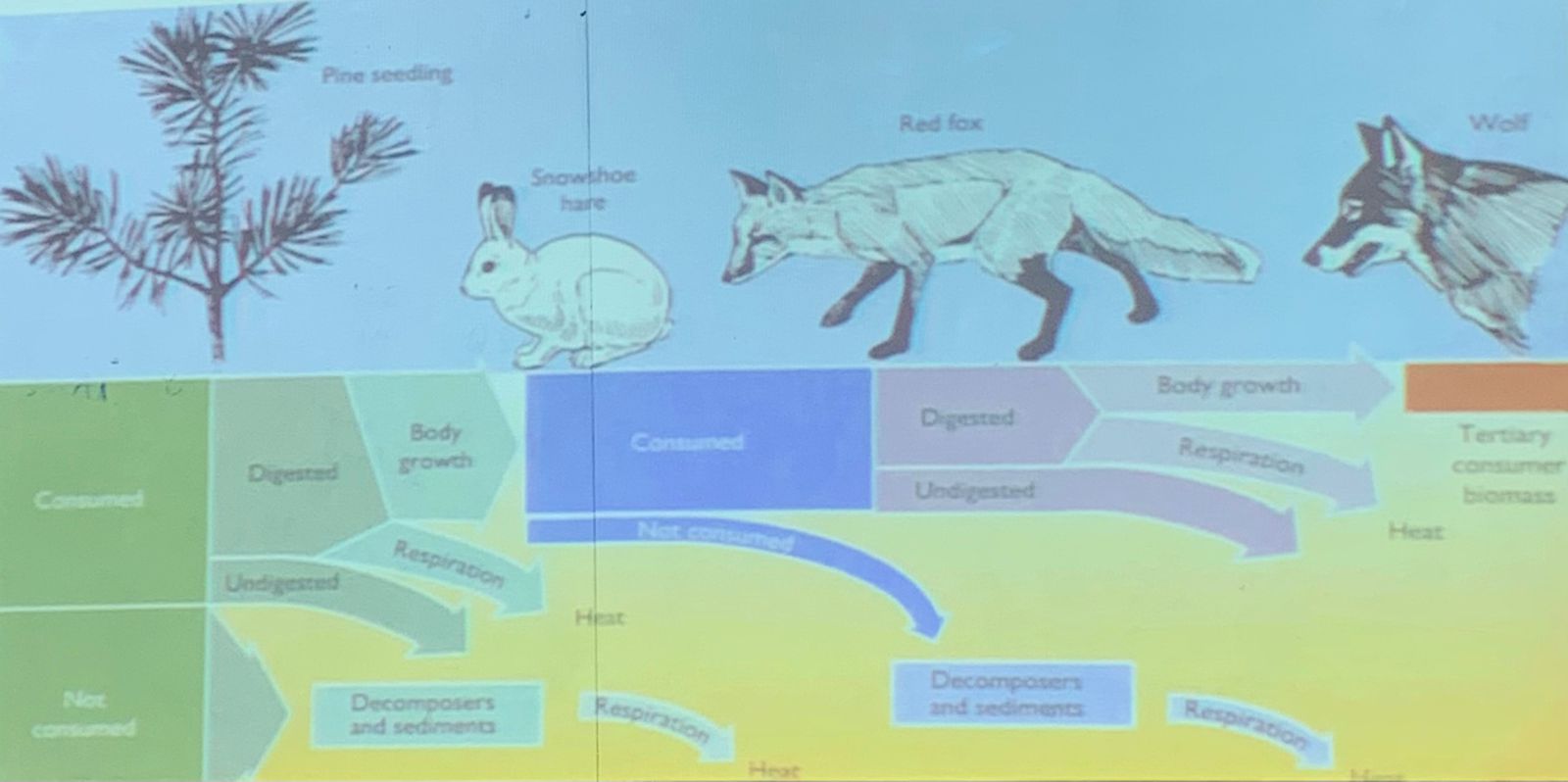
What’s Efficiency? → how much work i can do with the amount energy I have.
Its a comparison of the amount of work or energy done to the amount of energy that it consumed
Efficiency = useful outputs/inputs x 100
Ex. more efficient to eat plants bc theres less energy loss.
Implications of the 2nd law
Entropy will always increase, so in order to keep a body together organisms must continually put in energy such as food and sunlight.
Increase in entropy is reduced by an input of food as a source of energy. All living organisms respire, even at rest and energy stops them disitnergrating into a puddle of inorganic chemicals.
Living creatures manage to maintain theur order and defy entropy to stay alive by continuous input of energy
Energy is even required at rest
Low entropy solar energy turns into higher entropy chemical energy.
Chemical energy turns into much higher entropy mechanical energy and is lost as heat
→ This increases entropy of environment in which heat is dissipated.
As an open system, an eco system will normally exist im a stable equilibrium, either in a steady-state of equilibrium or in one developing overtime (ex. successions), and maintained by stabilizing negative feedback loops.
What’s Steady-state equilibrium?
Maintains a stable system due to constant flow of inputs and outputs.
Ecological system requires inputs and outputs in order to function.
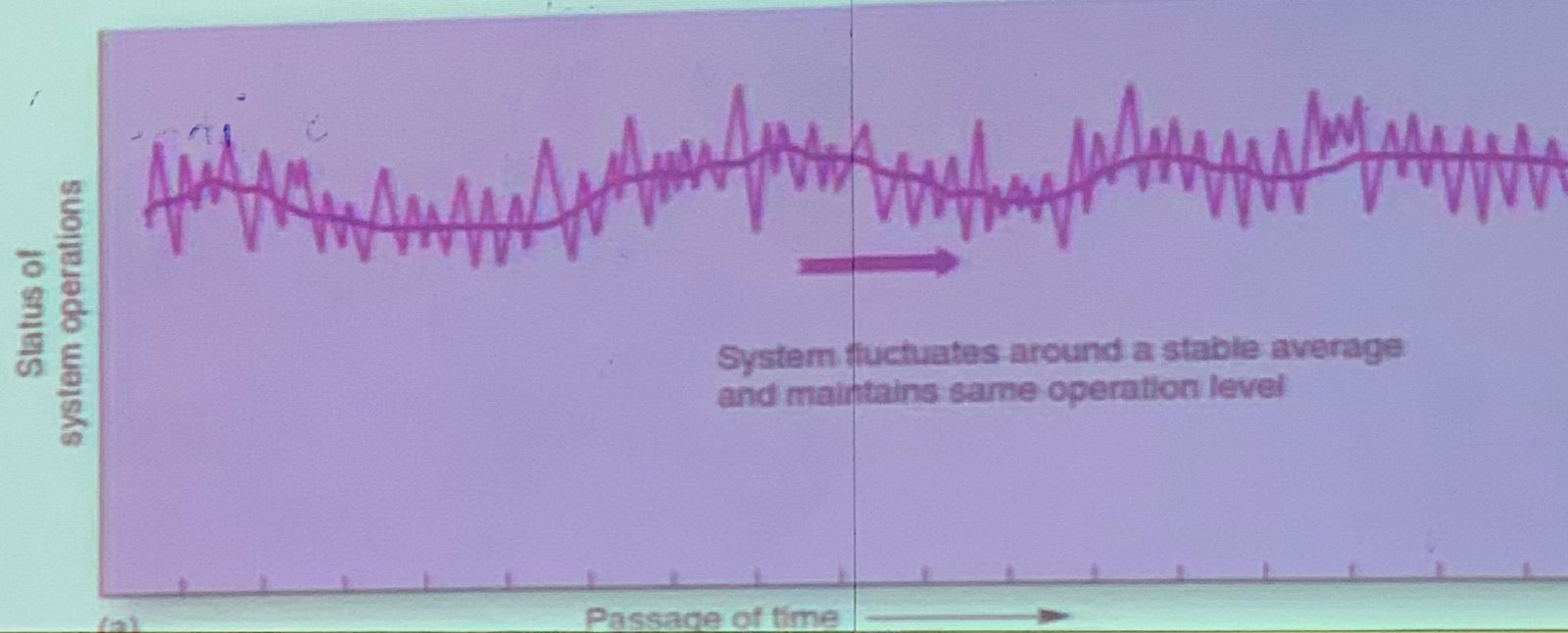
City with population is considered to be open system because energy can be absorbed by humans (through sunlight, or heat body of other people, and many more), and it will be transferred through different forms such as sweat, body heat, movements, and many more.
What’s Static equilibrium?
Doesnt apply to natural systems because no inputs/ outputs so no change occurs.
Always balance
Inanimate objects
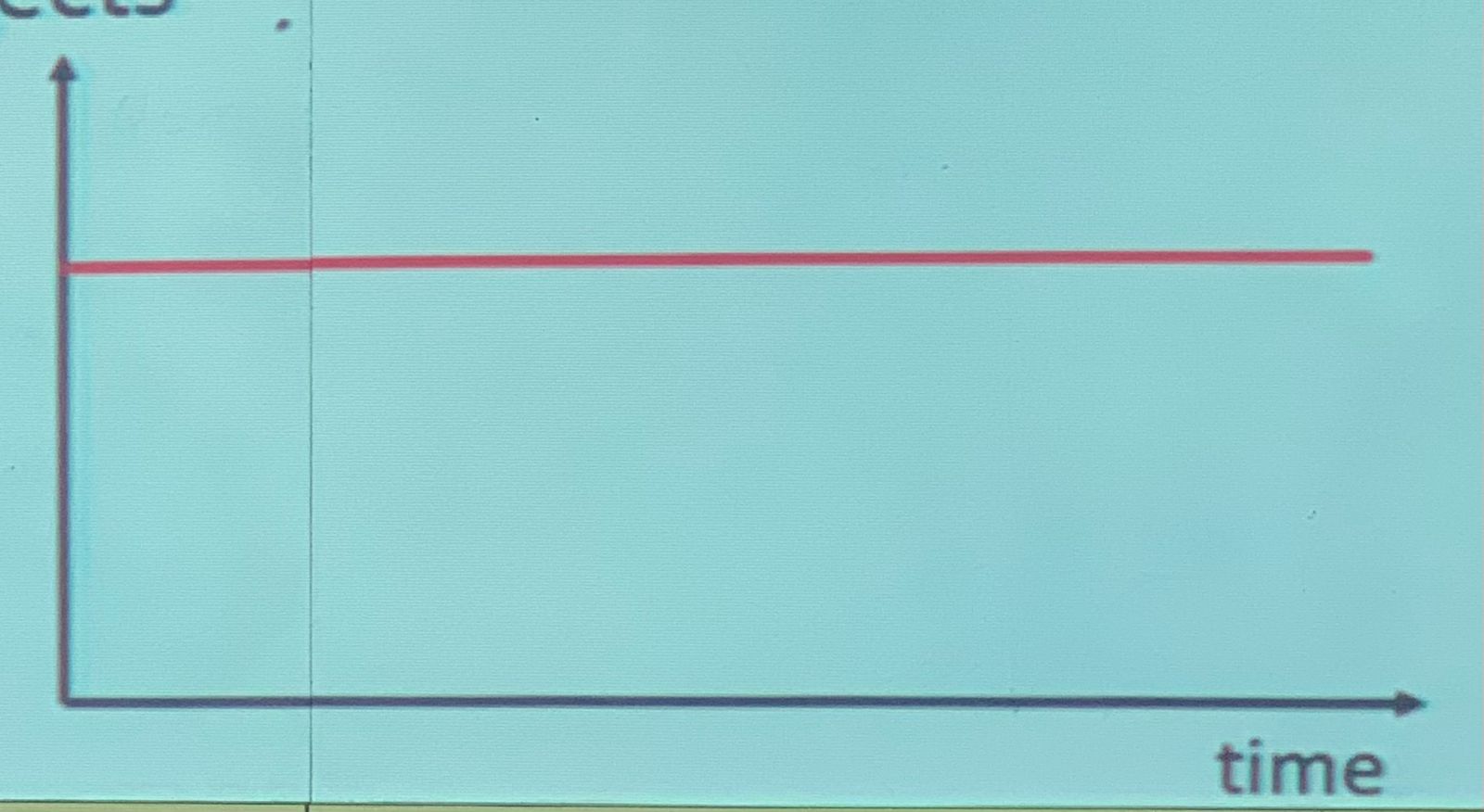
What does it mean when its ‘Stable’?
Returns to balance after disturbance (ex. rubber)
What does it mean when something is ‘Unstable’?
Achieves new balance after disturbance (ex. car crash → car doesn’t turn to normal)
What happens to a system thats an unstable equilibrium? It will not return to the original equilibrium and establish a new one.
What do plants need to perform photosynthesis? Sunlight
What does plants do when its night time? It adopts a new equilibrium to produce food also known as respiration.
Negative feedback loops (stabilizing) occur when the output of a process inhibits or reverses the operation of the same process in such a way as to reduce change—it counteracts deviation.
Ecosystems said to be “Self-regulating”
Each contain feedback mechanisms which function to maintain the system in its equilibrium state.
Positive
Negative
What’s Negative feedback? It dampens the effects and promotes return to stability.
examples:
Predator-prey relationships
Human body tempratures
What’s Positive feedback? Amplifies change and leads to deviation from stability.
Diverges from the equilibrium.
Change in x causes a change in y which causes a bigger change in x.
The resilience of a system, ecological or social, refers to its tendency to avoid such tipping points and maintain stability
The capacity of an ecosystem to respond to a disturbance.
Negative feedback More complex, more feedback looks more resilient.
Absorb disturbance without shifting to an alternative state and losing function and services. conditions
Disturbances can include
Fires
Flooding
Windstorms
Insect population explosions
Deforestation
Fracking
Pesticide
Diversity and the size of storages within systems can contribute to their resilience and affect their speed of response to change (time lags).
Some disturbances can significantly affect an ecosystem and can cause the ecosystem to reach a threshold beyond which some species can not recover.
Humans can affect the resilience of systems through reducing these storages and diversity
Positive Feedback tends to amplify and drive a system toward a tipping point
Minimum amount of change within a system that will destabilize it, causing it to reach a new equilibrium or stable state.
At a particular moment in time, a small change within a global climate system can transform a relatively stable system to a very different state of the climate
Identifying what phenomena are capable of passing tipping points can be tricky. “Tipping elements” is used to describe large-scale components of the Earth System which may be subject to tipping points.
Arctic Sea Ice
Ice Sheets
El Nino
Amazon Rain Forest
Feedback
Mutual casual interaction → x affects y, y affects x.
Whats Positive feedback? → Amplifies a particular state from previous conditions. Not necessarily good.
e.g. → Blood Clotting. The Menstrual Cycle. Labor and Childbirth. Digestion. Nerve Signaling.
What’s Negative feedbac?k → Wave-like equilibrium because it curtail the state for a period of time the state for a period of time.
e.g. → desert weak, rainforest strong, temperature regulation. Blood pressure regulation. Blood sugar regulation.
What happens when an interaction is taken away? The loop breaks.
What causes Negative feedback loops (stabilizing) to happen? It happens when the output dampens the effects and promotes a return to stability.
e.g. → fox eat rabbit, rabbit population goes down. Fox population goes down, rabbit population increases.
What does positive feedback loops amplify? It amplify change and deviates from stability.
e.g. → temprature → permafrost thaws → greenhouse gases release (and repeat).
Positive feedback stacks.
Whats Resilience of a system
Tendency to avoid tipping points (when balance tips to such a point that it cannot return) and maintain stability/ respond to a disturbance.
absorb disturbance without shifting to a different state and losing function.
More complex, more feedback looks more resilient.
What are examples of Disturbances?
Fires, flooding, insect population explosions, pesticides, windstorms, and fracking, and many more.
Some disturbance can significantly impact an ecosystem that some species cannot recover (threshold).
Size of storages = amount of storages in a system
What are examples of Climate Emergencies around the world?
China heatwaves, Record breaking temp in Europe, Scientists have been wake up call -ing for years.
08/10/2023 - Resilience (1.4)
Objectives:
Outline what is resilience
How resilience can be affected by humans
Activity
Describe sustainability and sustainable development
Humans can affect the resilience of systems by reducing these storages and diversity.
Positive feedback tends to amplify and drive a system toward a tipping point.
The minimum amount of change within a system that will destabilize it → causing it to reach a new equilibrium or stable state.
Small changes within a global system can transform a relatively stable system into a very different state of climate.
Identifying phenomena are capable of passing tipping points can be tricky
Tipping elements → used to describe large-scale components of the earth system which may be subject to tipping points.
Arctic sea ice
Ice sheets
El Nino (Warmer water spreads further and stays closer to the surface).
Amazon rain forest
Places considered to be red zones are →
Apo Island Marine Sanctuary: Negative tip
Tipping point = Intro of destructing fishing methods
More use of destructive methods
Degradation of coral reef habitat and fish stocks
More fishing away from island
less concern for sustainability of marine eco system
What is the tipping point
Bowary → Manhattans lower east.
Eco tipping point → small action that became a catalyst for major change.
Bowery → agricultural district.
Lake known as a collect pond was a favorite fishing spot.
Bowary decline at the end of 1700s. due to pollution accumilating as local manufacturers increased in production and waste. Population also exploded.
1800s elevated railroad → buildings became trash dumps and flop houses.
The lake got polluted aswell
HW: Find a place in Indo that can be counted as sustainable
Parepare, South Sulawesi as the Most Sustainable City in the Field of Energy and Climate Change.
08/24/2023
Distinguish between MEA and EIA
EIAs → Incorporate baseline studies before a development project is undertaken.
What's their job? They assess the environmental, social, and economic impacts of the project, predicting and evaluating possible impacts and suggesting mitigation strategies for the project.
Usually followed by an audit and continued monitoring. Each country or region has different guidance on the use of EIAs.
When is it prepared? Before a proposed large-scale project.
What steps do you take?
Baseline Study → Looks at potential changes to biodiversity, climate and amenities as well as potential effect on people in the area and changes to their community structure, livelihood or health.
Forecasts and predictions about the impact of the proposed project, then can make the change accordingly to minimize impact.
MEA → International assessment of the effects of human activity on the environment.
Gives a scientific appraisal of the condition of the world’s ecosystems.
Who are the participants? Reps from UN, NGO, academics, business leaders, reps from indigenous people.
Summarize
What must EIA include?
aBaseline study to record current situation.
A survey: A report to assess the potential impact of the project
A prediction to indicate the importance of the likely impact
A summary to consider how the effects can be limited to reasonable extent.
Sustainability
Ecological limits must be set. We owe it to ourselves cause its our future. Concious consumers might be 'organic' products that may use less chemicals that uses fossil water and dependent on people who are marginalized. Rainwater should be in groundwater. We dontknow where our waste goes, but we have to try to not cause any waste in the 1st place (give up bottled water -> by bringing own bottle). Carbon emissions makes it diffuclt for humans to sustain life on earth. We dont know where cheap products come from. Because victims arent infront of us we wouldnt do the wrong things. We cannot shop our way to sustainability. We gotta do fundemental things (change). Zero emission vehicles, the emissions will just go somewhere else. Cars are not the solution for. Cars are clogging our bodies and cities. Use bicycles, less traffic, and many more. Plant trees/ plants. After eating turn food to compost. 'How can I live interconnected'.
Levels of Pollution Management (1.5)
What’s pollution??
Adding something to an environment
Made or caused by human activity
Added faster than it can be treated
Affects organisms
→(Substance)→(Environment)→(Harmless Agent)
Examples includes:
The contamination of air water soil by substances that are harmful to living organisms.
Naturally (ex. volcanic eruptions), or unnaturaly (ex. spilling of oil and disposal or industrial waste)
Classifications
Matter (solids, liquids gases)
Organic (containing carbon)- sewage
Non-organic-plastics
Pollutants may be in the form of organic or inorganic substances, light, sound or thermal energy, biological agents or invasive species, and may derive from a wide range of human activities including the combustion of fossil fuels
Organic & Inorganic
Light, sound, thermal pollution
Biological agents
Invasive species
Fossil fuels
Human activites
Pollution may be nonpoint or point source persistent or biodegradable, acute or chronic
Sources of Pollutions
Fossil fuels - release greenshouse gases, can contribute to respiratory problems and acid rain.
Domestic waste - food waste, sewage, rubbish (glass, plastics, paper, wood, metals)
Industrial waste - Heavy metals, heat (in air and or water) , acids.
Agricultural waste - Fertilizers, animal waste, and pesticides contaminate water sources.
Point sources → pollution can be traced back to its origin or source.
Regulation is ez
Localized
Often a single paett is respinsible
One jusrisdiction
Examples
Drainage pipe
Leaking storage tank
Factory chimney
Non point sources → Pollution which cannot be traced back to a single origin or source (ex. storm water runoff, water runoff from urban areas and failed septic systems).
Regulation is more challenging
Identify multiple sources
Who is responsible
Different legal jurisdictions
Large-scale intervention
Examples
Agricultural runoff
Vehicle exhaust
Industrial emissions
Persistent Organic Pollutants (POPs) – resistant to environmental degradation through chemical, biological, and photolytic processes.
Persistent Organic Pollutants (POPs) –
Can’t be broken down by living organisms
Passed along food chains as a result
Concentrations build with each higher tropic level resulting in biomagnification
Examples:
Heavy metals
Older pesticides such as DDT
PCBs
Dioxin
Biodegradable - Capable of being decomposed by bacteria or other living organisms
Does not build up in individuals or get passed along food chains
Examples:
Sewage
Food waste
Most modern pesticides
Degradable plastic bags
Pollution may be nonpoint or point source persistent or biodegradable, acute or chronic.
Acute –large amounts of pollutant released at one time
Symptoms appear soon after short, intense exposure
Bhopal Disaster 1984
Chronic - Long term relrease of small amount.
Symptoms appear after long-term, low-level exposure.
E.g. Pollution
Pollutant may be primary (active on emission) or secondary (arising from primary pollutants undergoing physical or chemical change).
You have to write down the whole thing.
Primary –1streleased directly from the source
Secondary –2ndform from interactions of primary pollutants with one another or the environment.
e.g → Primary pollutants: More carbon monoxied released ffrom the incomplete combustion of fossil fuels.
Secondary pollutant it undergoes a change (during its output), it could mix with something else.
Examples
Formation of acid rain (NO2, NO3 + H2O → HNO3 (Nitric Acid))
Formation of smog (smoke + fog).
Depletion of ozone (O3).
Construct system diagrams to show the impact of pollutants
What should the diagrams include?
Storages
Sinks
Flows (Inputs and Outputs)
Pollution management stratgeies can be applied at different levels
Measuring pollution
Directly
Water/soil pollution
Nitrates and phosphates
Organic matter or bacteria
Heavy metals
Air Pollution
Acidity rainwater
Amount of particles emitted by a diesel engine
Indirectly
Abiotic factors
Dissolved oxygen there is in the water (If there is less oxygen → its polluted, and vice versa.)
Biotic factors
Lichen on trees
Invertebrates in the water (check for mayflies in water → its not polluted)
Pollution management strategies (Important!!!)
Level 1 - Changing human activities to prevent/reduce the release of pollutants.
e.g. → use tote bags, reduce reuse recycle, use solar panels, busway, and etc.
They are the most proactive.
Give alternative solutions.
Educate/ raise awareness.
Legislation (Change for more for electricity/gas)
Economic incentives (rebates (discount/subsidy) for solar panels).
Difficult to achieve (bc its necessary to change the behavior of people, business, and or government).
Level 2 - Prevent or regulate the production/release of pollutants.
Legislation and regulation (e.g. emissions standards for cars).
Develop technology for extracting pollutants (e.g. filter/ ways to not allow the pollutant to go) If you wanna read about it, read whats blue amonia.
Monitoring is easy (bc theres regulations)
Strategy fails to fully address the problem because pollutant is still being produced.
Level 3 - Working to clean up or restore damaged ecosystems
Last resort, there is already an impact
Removing pollutant from ecosystem (think trash)
Replanting/ restocking lost or depleted populations
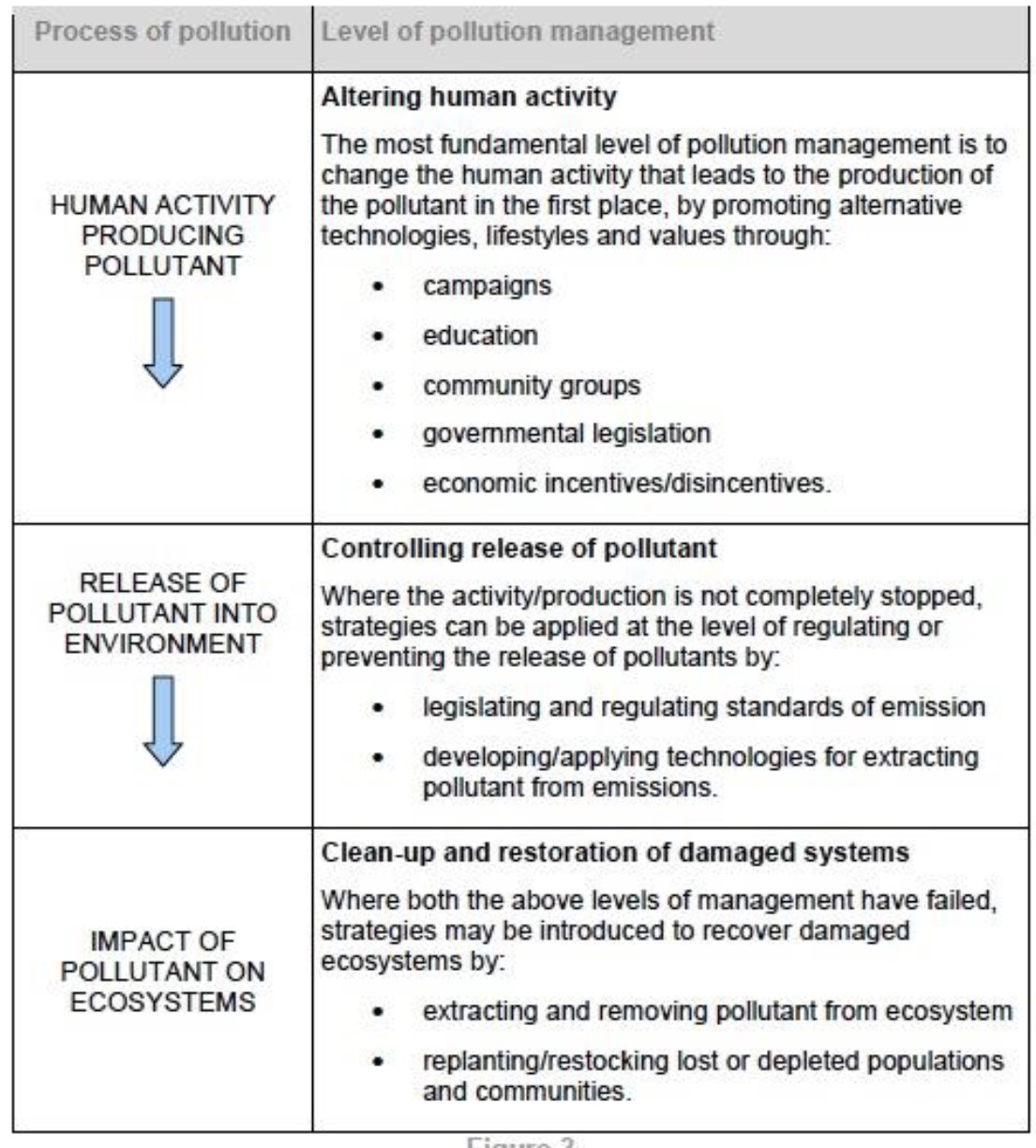
Human factors affect management
Cultural
Improvished pollute less because they consume less.
Pollution management strategies can be applied at different levels.
Substence farmers may pollute less because they have more intimate relationship with land
Capitalist socities often consider profit over environmental damage
rural society might have “out of sight out of mind” mindest
Political
Weak regulations and lack of enforcement in LEDCs (i.e.Nigeria’s oil delta
Strong corporate involvmenetand lobbying in policy decisions in MEDCs (i.e.US Congress)
Human Factors Affect Management
Economic
MEDC’s have luxury of worrying about clean environment
People in poverty recycle more out of necessity
Cheaper to continue to pollute
If fines and punishments are less than the cleanup or reduction costs, polluting continues
Evaluate
weigh the pros and cons, then reach a conclusion about which are more significant
Think of it as a cost benefit analysis
How is each intervention level successful?
What hinders the success of each intervention level?
Which level is likely to be the most effective and feasible to implement?
Justify your conclusion with reasons and evidence
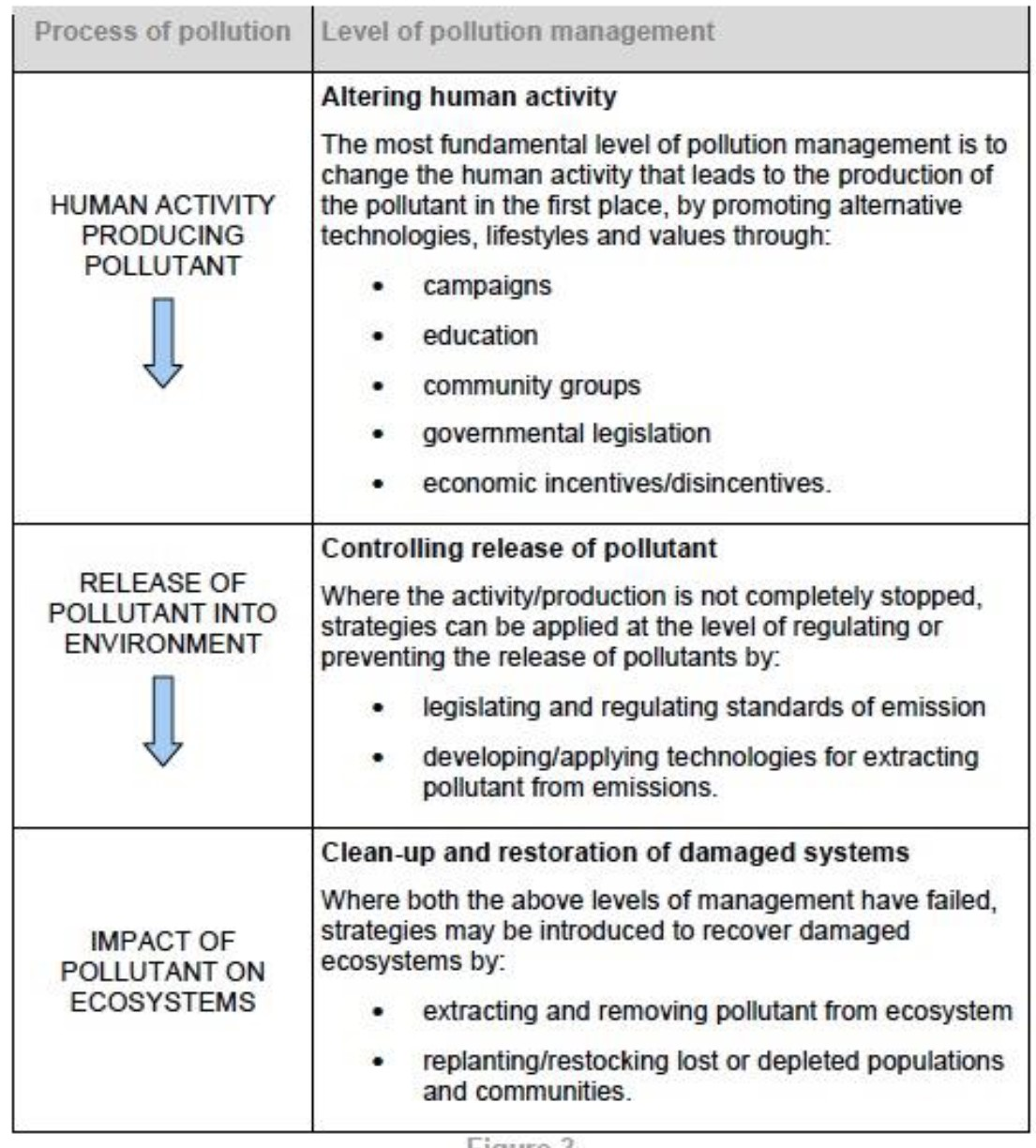
Dichlorodiphenyltrichloroethane(DDT) exemplifies a conflict between the utility of a “pollutant” and its effect on the environment
DDT kills mosquitoes and lice
However, its impact on human health and the environment is less clear: killing mosquitoes stops people from dying, but at what cost to the health of the overall population
DDT invented during WW2 to combat typhus and malaria
Later used widely in agriculture
Health impacts of DDT:
Some studies found increased rates of
Asthma and diabetes
Liver, breast, and pancreatic cancers
Early pregnancy loss, premature birth and low birth weight–Male infertility in exposed populations
Case Study•American Bald Eagle
Common throughout North America
Reduced to as few as 400 nesting pairs by 1960s
Decline caused by habitat loss and widespread us or DDT
Toxins accumulate in the fatty tissue of adults–Egg shells too thin to survive
Evaluate use of DDT:
What are the pros and cons?
What are the successes?
What are the problems?
Which are more important
Be careful in looking at sources. Are they biased? Can they substantiate their claims
Systems:
Advantages
•Can predict and simplify complex systems•Bring out patters
•Simplified versions of real life
•Inputs can be changedand outputs examined without waiting for real events
•Results can be shown to others
Disadvantages
•Lack of detail may not be accurate
•Rely on the expertise of those making it
•Different people may interpret them in different ways
•Vested interests may hijack them politically
•Only as good as the data that goes in
•Different models may show different effects with same data
purple - understanding
brown/ rust - application question
green - skill u need to have